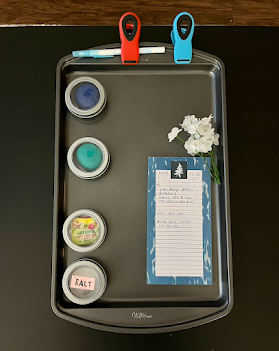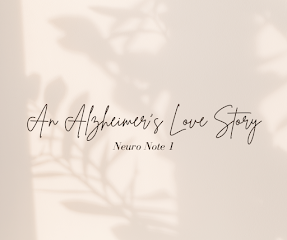A Cookie Tray and GBS. How OT-ish!
OT school never fails to surprise me with how much knowledge I have gained so far and how I am able to apply it in real-life scenarios. In my Neuro Aspects class, we were each assigned a client with one of the conditions we learned about in class, and each one of us was given three specific household materials to work with, however, we had to use at least one of the materials given innovatively.
My client, Jane, is a 33-year-old Registered Nurse in a Pediatric Hospital who has recently been diagnosed with GBS. Jane was in pretty good health, however, she was in the hospital for four days for what seemed to be the flu with her symptoms being mild fever, swollen neck, fatigue, and diffuse joint pain and swelling. Once she got better, she started to feel pins and needle sensations along with numbness in her hands as well as weakness in her lower extremities. (So she just had the flu and now is feeling weakness in her lower extremities?) Through lab work, multiple tests, and observing the progression of her weakness, she was diagnosed with GBS. She had breathing support and needed total care in the ICU for the next month so she could improve her health slowly. Jane has now been moved out of the ICU to the neuro floor at an acute care facility. She can now ambulate for short distances with standby assistance, has mild to moderate fatigue, and has some residual signs of distal weakness affecting mostly her fine motor skills.
The beautiful thing about OT is how holistic, creative, and resourceful this field is. To make OT sessions meaningful to the client, it is important to note what they like to do in their free time and incorporate that. Jane's occupations consist of hanging out with her friends, taking cooking and pottery classes, and working in her garden. She looks forward to being able to get back to her routine as well. As I am looking at the household materials assigned to me (paper straws, a pair of dice, and a cookie tray), I'm speechless at what I could make as an intervention for Jane. I hit a lot of dead ends and felt so lost until I realized I truly wasn't thinking outside the box. And that's when it came to me. A cookie tray... has to be magnetic, right? I'm sitting here researching cool gadgets and gizmos with magnets and seeing how I could incorporate this in an OT session with Jane. And here I present my awesome multi-purposeful intervention.
A cookie tray has now been transformed into a portable multipurpose magnetic tray for our client Jane. There are many purposes of the multipurpose magnetic tray, the main one being an energy conserver especially with Jane having mild to moderate fatigue. Having a few of her basic essentials right there on the tray can help conserve some energy (sitting with the tray instead of standing). I used 4 magnetic containers I found at Dollar Tree as well as a notepad so Jane can write any thoughts or keep up with her daily routine list. She can even make a visual schedule on the notepad to remind her of any main tasks she has for the day and remind her to slowly add other tasks into her daily routine so she can gradually get back to her normalcy. I included some clips for any multipurpose use with gripping and fake florals onto the tray as well. Within the magnetic containers, two of them are filled with Play-Doh, and the other two are filled with cooking-related essentials. Both containers correspond to her occupations of enjoying pottery and cooking class as Play-Doh can resemble clay and the other two containers are filled with cooking-related essentials that can come in handy for a portable cooking activity that might come up. I currently filled those containers with salt (because everyone loves a little salt, right?) and accessible green tea bags as Jane loves to hang out with her friends, and what better way to hang with the girls and spill some tea while drinking some tea! Of course, the containers are interchangeable so Jane is allowed to fill them up with anything she wants. I added some fake flowers to incorporate her garden as she enjoys working on it but has taken a break since her diagnosis. It can be kept as decor or she can make a garden using the Play-Doh and stick the florals in it. Considering how multi-purposeful it is, Jane can decide later on if she wants to use it as adaptive equipment in the kitchen and fill all the containers with spices or other accessible things or to keep it as a creative tray and use it recreationally to get her creative juices flowing with the Play-Doh.
As it was mentioned before, Jane has residual signs of distal weakness that are affecting her fine motor skills. We use fine motor skills every day without realizing it. Fine motor skills consist of using the intrinsic muscles, especially within the hands, and how it helps with gripping objects. Texting your friends, untwisting your water bottle cap, tying your shoes, buttoning your shirts, manipulating objects, all the small things! For Jane's case, adding the magnetic containers as well as the clips helps strengthen her fine motor skills, especially twisting and gripping. She can twist the container lids off at first until she has the strength to fully pop the lids off. She can build her strength by using the Play-Doh in the containers and playing around with it by rolling, pinching, and even gripping it. Once the Play-Doh is a bit easy, we can use the clips to grip the Play-Doh or even incorporate a sturdier type of clay that makes Jane work her intrinsic muscles a bit more as well as help strengthen her distal weakness.
Even though this project had me hit a few dead ends, once I had my creative juices flowing, I got excited about seeing how this intervention was going to turn out. When it comes to being a future Occupational Therapy Practitioner, it is all about thinking outside the box when we approach things. It is always important to think about how accessible and functional something is as well as incorporating what is meaningful to the client in order to keep things creative and meaningful. The feeling I had once my intervention came together made me feel creative and innovative, which makes me excited to know I am one step closer to doing this in the real world soon with real clients. If it could mean this much to me, imagine how much it could mean to my future clients! I need to keep viewing things differently and keep thinking outside the box so it can all come more naturally to me in the future!






Comments
Post a Comment